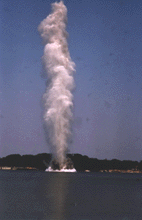Powerful Data Analysis Routine Helps Locate Buried Bombs
By Christian Barthel, Vice President, Barthel & Schreiber GmbH,
Duisburg, Germany Ralf Rosenberger, ADDITIVE Soft- und Hardware
für Technik und Wissenschaft GmbH, Friedrichsdort, Germany. May
1999.
|

Once an underwater bomb is located, specialists are called
in to defuse or detonate it
|
Experts estimate 5 percent of
the 440,000 Allied bombs dropped on Berlin failed to explode
due to faulty fuses, poor assembly, bad angle of impact and
other reasons. Although millions of unexploded bombs and artillery
shells have been cleared and defused since World War II, officials
estimate thousands remain buried all over Germany. Unexploded
wartime bombs are often found in Germany, especially by construction
crews in the former East Germany, which has seen widespread
reconstruction since reunification in 1990. Most are still
live and potentially explosive. In September 1994, a 550-pound
American bomb blew up during drilling for a foundation in
eastern Berlin, killing three workers. Bombs turn up so frequently
that Germans have come to view them less as a looming danger
than as an annoyance because of the temporary evacuations
and traffic tie-ups that usually follow a discovery. Of the
10 bombs found in Berlin in 1997, two popped up in June and
July during construction of new presidential offices next
to the Bellevue Palace, the president's official residence
in the heart of the city.
|
Tractor tows sensor
There are three major companies in Germany that specialize in locating
unexploded bombs. Barthel & Schreiber GmbH, with 70 employees is
the largest concern that handles water searches. The vice president
of the firm is the only person in Germany with a specific degree
in bomb identification.
| The
company has several ships,including one built entirely from
aluminum, that it uses to locate underwater bombs. To identify
underground bombs, the company uses tractors to tow an aluminum
trailer ten feet that contains magnetic sensors behind the vehicle.
Aluminum is used in the ship and trailer to avoid false positive
readings from the magnetic sensors, which are highly sensitive
detectors of ferrous materials. The driver of the tractor is
guided by a GPS system that helps maintain the path of the vehicle
to follow a predefined grid. In about 8 hours, a single tractor
can scan an area of about 1000 meters by 500 meters. A personal
computer with a Keithley analog/digital converter card collects
sensor readings at a rate of 20 samples per second. The result
is a file on the order of 50 Megabytes in size. |
 Although millions of unexploded bombs and artillery shells
have been cleared and defused since World War II, officials
estimate thousands remain buried all over Germany.
Although millions of unexploded bombs and artillery shells
have been cleared and defused since World War II, officials
estimate thousands remain buried all over Germany.
|
Barthel & Schreiber developed a software
package that reads the GPS signal, keeps track of the tractor's
position and provides course correction information to the driver.
They needed a program that could acquire the magnetic sensor data
and correlate it to the GPS data, then perform proprietary analysis
routines developed by the firm that help to separate bombs from
hubcaps, tools and pieces of scrap metal, and finally generate a
large-scale plot that would pinpoint the position of each possible
bomb. The firm considered developing the program from scratch but
determined that the cost would be astronomical. It investigated
several commercial data analysis programs that had programming languages
capable of coding the data analysis routines used to identify bombs.
The problem was that any one of these relatively high level languages
would have run the proprietary routines so slowly that it would
have taken days if not weeks to analyze a single day's data. Continued...
